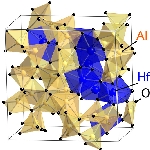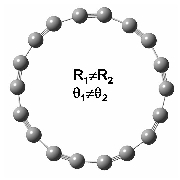Materials Science
Dielectric Materials: High-k Materials
 The complementary metal-oxide-semiconductor (CMOS) transistor has a great advantage that its performance can be improved by reducing its size. However, we have a serious gate leakage current problem for next-generation CMOS because of the size reduction itself. To overcome this problem, use of high dielectric constant (high-k) materials as gate insulators in future CMOS devices has been proposed and investigated. Generally, dielectric response of the high-k materials originates from electronic and ionic polarizations induced by an external electric field in the CMOS operation frequency. Considering both the electronic and ionic polarization contributions to the total dielectric constant, we have theoretically investigated the dielectric constants of the promising candidate high-k materials, Al2O3, HfO2, HfAlO (Figure shows an amorphous Hf0.2Al0.8O1.6 model structure), HfSiO, and CeO2. Calculation method is based on the first-principles. Calculated dielectric constants of the high-k materials are in good agreement with experimental results, and have significant contribution of ionic polarization to the dielectric constants. The first-principles approach is effective for studying the dielectric response of the high-k materials.
The complementary metal-oxide-semiconductor (CMOS) transistor has a great advantage that its performance can be improved by reducing its size. However, we have a serious gate leakage current problem for next-generation CMOS because of the size reduction itself. To overcome this problem, use of high dielectric constant (high-k) materials as gate insulators in future CMOS devices has been proposed and investigated. Generally, dielectric response of the high-k materials originates from electronic and ionic polarizations induced by an external electric field in the CMOS operation frequency. Considering both the electronic and ionic polarization contributions to the total dielectric constant, we have theoretically investigated the dielectric constants of the promising candidate high-k materials, Al2O3, HfO2, HfAlO (Figure shows an amorphous Hf0.2Al0.8O1.6 model structure), HfSiO, and CeO2. Calculation method is based on the first-principles. Calculated dielectric constants of the high-k materials are in good agreement with experimental results, and have significant contribution of ionic polarization to the dielectric constants. The first-principles approach is effective for studying the dielectric response of the high-k materials.
Dielectric Materials: Low-k Materials, SiOCH
 Fig. View of a molecular model structure of an SiOCH film.Materials with lower dielectric constants (low-k) are needed for the intermetal dielectrics of future silicon devices. The most promising candidate material for the low-k dielectrics currently is the SiOCH film. However, the conventional SiOCH films of smaller k-value, which are porous usually, are less compatible to the device fabrication because of the smaller mechanical strengths. We therefore have to find appropriate chemical-level modifications of SiOCH films to achieve both high mechanical strength and low dielectric constant.
Fig. View of a molecular model structure of an SiOCH film.Materials with lower dielectric constants (low-k) are needed for the intermetal dielectrics of future silicon devices. The most promising candidate material for the low-k dielectrics currently is the SiOCH film. However, the conventional SiOCH films of smaller k-value, which are porous usually, are less compatible to the device fabrication because of the smaller mechanical strengths. We therefore have to find appropriate chemical-level modifications of SiOCH films to achieve both high mechanical strength and low dielectric constant.
To explore the appropriate chemical structures for the high-modulus and low-k films, we have studied structures and properties of SiOCH films theoretically using atomistic model structures [1,2]. Theoretical calculations of SiOCH low-k films have been quite rare since methods to create atomistic models of amorphous polymers with cross-links like SiOCH have been absent. We employ an original approach for the computational molecular modeling of SiOCH films.
References
1) N. Tajima et al., Appl. Phys. Lett. 89, 061907 (2006).
2) N. Tajima et al., Jpn. J. Appl. Phys. 46, 5970-5973 (2007).
Carbon clusters
 Carbon clusters Cn attract much interest in connection with the formation of fullerenes, nanotubes, conducting polymers, and thin solid diamond films. Nonetheless, our understanding of structure and electronic properties of carbon clusters, especially of smaller-sized ones, is far from satisfactory. Among the Cn clusters, C4n+2 carbon rings attracted much attention because they exhibit competing many-body effects of Huckel aromaticity, second-order Jahn-Teller effect, and Peierls instability at large sizes. Occurrence of Peierls-like distortion of bond alternation is one of the important topics in 4n+2 rings.
Carbon clusters Cn attract much interest in connection with the formation of fullerenes, nanotubes, conducting polymers, and thin solid diamond films. Nonetheless, our understanding of structure and electronic properties of carbon clusters, especially of smaller-sized ones, is far from satisfactory. Among the Cn clusters, C4n+2 carbon rings attracted much attention because they exhibit competing many-body effects of Huckel aromaticity, second-order Jahn-Teller effect, and Peierls instability at large sizes. Occurrence of Peierls-like distortion of bond alternation is one of the important topics in 4n+2 rings.
In this carbon cluster area, we study the most reliable structure and energetics of the ring isomers of C4n+2 carbon clusters by using CCSD theory. Our studies1 indicate that C14, C18, and C22 carbon rings have bond-length and bond-angle alternated acetylenic minimum energy structures (Figure) contrary to the conclusions made in many of the earlier studies. From our studies, it is certain that the lowest energy ring isomer of the C4n+2 (n = 1,2) rings has a bond-angle alternated D(2n+1)h symmetric structure, while the same of the C4n+2 rings with n = 3 – 5 has bond-length and bond-angle alternated C(2n+1)h symmetry structure. Peierls-type distortion occurs at C14 in the C4n+2 carbon rings. Now we study the absorption spectra of these Cn clusters by using SAC-CI theory.
References
(1) S. Arulmozhiraja and T. Ohno, J. Chem. Phys. 124, 114301 (2008).
